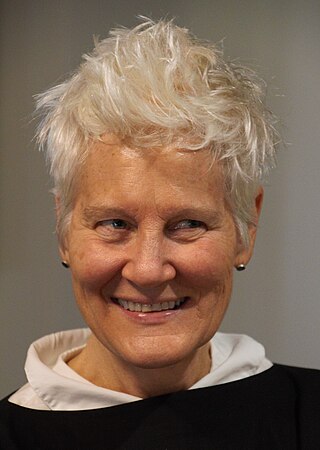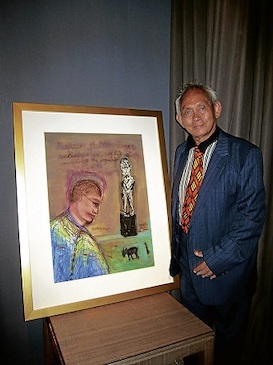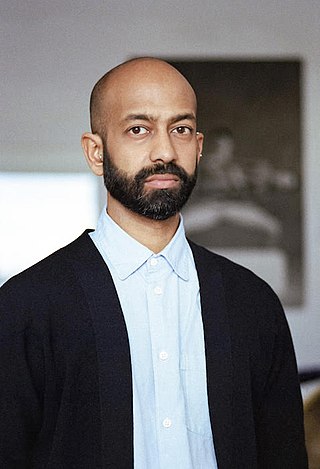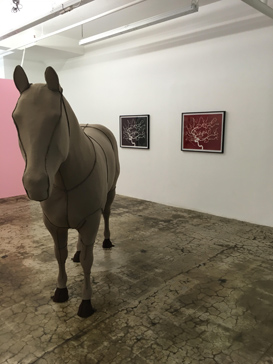Related Research Articles

Dan Flavin was an American minimalist artist famous for creating sculptural objects and installations from commercially available fluorescent light fixtures.
Hans Haacke is a German-born artist who lives and works in New York City. Haacke is considered a "leading exponent" of Institutional Critique.
Gabriel Orozco is a Mexican artist. He gained his reputation in the early 1990s with his exploration of drawing, photography, sculpture and installation. In 1998, Francesco Bonami called Orozco "one of the most influential artists of this decade, and probably the next one too."

Ann Hamilton is a visual artist who emerged in the early 1980s known for her large-scale multimedia installations. After receiving her BFA in textile design from the University of Kansas in 1979, she lived in Banff, Alberta, and Montreal, Quebec, Canada before deciding to pursue an MFA in sculpture at Yale in 1983. From 1985 to 1991, she taught on the faculty of the University of California at Santa Barbara. Since 2001, Hamilton has served on the faculty of the Department of Art at the Ohio State University. She was appointed a Distinguished University Professor in 2011.

David Cortez Medalla was a Filipino international artist and political activist. His work ranged from sculpture and kinetic art to painting, installation, and performance art.
Roberto "Bobby" Rodríguez Chabet was an artist from the Philippines and widely acknowledged as the father of Philippine conceptual art.
Onib Olmedo was a Filipino painter acclaimed by critics as one of the major Filipino artists of the 20th century. Olmedo created a body of works that utilizes the expressionist technique of distortion to portray the inner torment experienced by modern man.
Federico Solmi is a visual artist based in Brooklyn, New York.

Dominique Gonzalez-Foerster is a French visual artist and educator. She is known for her work in video projection, photography, and art installations. She has worked in landscaping, design, and writing. "I always look for experimental processes. I like the fact that at the beginning I don't know how to do things and then, slowly, I start learning. Often exhibitions don't give me this learning possibility anymore."

The Deutsche Guggenheim was an art museum in Berlin, Germany, open from 1997 to 2013. It was located in the ground floor of the Deutsche Bank building on the Unter den Linden boulevard.

Simone Leigh is an American artist from Chicago who works in New York City in the United States. She works in various media including sculpture, installations, video, performance, and social practice. Leigh has described her work as auto-ethnographic, and her interests include African art and vernacular objects, performance, and feminism. Her work is concerned with the marginalization of women of color and reframes their experience as central to society. Leigh has often said that her work is focused on “Black female subjectivity,” with an interest in complex interplays between various strands of history. She was named one of the 100 most influential people in the world by Time magazine in 2023.
The Guggenheim UBS MAP Global Art Initiative is a five-year program, supported by Swiss bank UBS in which the Solomon R. Guggenheim Foundation identifies and works with artists, curators and educators from South and Southeast Asia, Latin America, and the Middle East and North Africa to expand its reach in the international art world. For each of the three phases of the project, the museum invites one curator from the chosen region to the Solomon R Guggenheim Museum in New York City for a two-year curatorial residency, where they work with a team of Guggenheim staff to identify new artworks that reflect the range of talents in their parts of the world. The resident curators organize international touring exhibitions that highlight these artworks and help organize educational activities. The Foundation acquires these artworks for its permanent collection and includes them as the focus of exhibitions that open at the museum in New York and subsequently travel to two other cultural institutions or other venues around the world. The Foundation supplements the exhibitions with a series of public and online programs, and supports cross-cultural exchange and collaboration between staff members of the institutions hosting the exhibitions. UBS is reportedly contributing more than $40 million to the project to pay for its activities and the art acquisitions. Foundation director Richard Armstrong commented: "We are hoping to challenge our Western-centric view of art history."

Brendan Fernandes is a Canadian contemporary artist. He specializes in installation and visual art and currently serves as a faculty member at Northwestern University teaching art theory and practice.
Meg Webster is an American artist from San Francisco working primarily in sculpture and installation art. While her works span multiple media, she is most well known for her artworks that feature natural elements. She is closely affiliated with Post-Minimalism and the Land Art movement and has been exhibiting her work since 1980.
Yoshinori Niwa is a Japanese artist currently based in Vienna, Austria, his self-explanatory work as social interventions realised through diverse media including performance, video and installation.
Ringo S. Bunoan is a Filipino artist, curator, research and writer based in Manila, Philippines. She is known for her conceptual approach, working across media in installation, sound, video, bookworks and writing. She earned her bachelor's degree in Art History from the University of the Philippines, Dillman. Her works have been shown in galleries, museums and alternative art spaces in Manila, across Asia and the Pacific and USA, including Center for Contemporary Photography, Melbourne, 4th Gwangju Biennale, Singapore Art Museum, Busan Biennale Sea Art Festival, Asian Art Museum, Walter McBean Galleries in San Francisco and REDCAT Gallery in Los Angeles, and Campbelltown Arts Centre, Sydney.
Kiri Dalena is a visual artist, filmmaker and human rights activist who lives and works in the Philippines. Her work deals with issues of political and social injustice, drawing from events in Philippine history.
Electric Djinn is the solo musical project of American electronic musician and producer Neptune Sweet, based in New York City. Her EP is entitled The Singles (2014). She has also released two singles: "Deer Xing" (2015), the video for which was reviewed by Tiny Mix Tapes, and "Phoenix" (2019).

Liz Young was a Los Angeles-based artist known for diverse work investigating body- and nature-focused themes, such as loss, beauty, the inevitability of decay, and the fragility of life. She produced sculpture, installation, performance, painting, drawing and video incorporating fabricated and recontextualized found objects, organic materials, and processes from industrial metalworking to handicrafts, taxidermy and traditional art practices. Young exhibited throughout the United States and Europe, including solo shows at the Los Angeles County Museum of Art (LACMA) and Los Angeles Contemporary Exhibitions (LACE), and alternative spaces such as Hallwalls, Randolph Street Gallery (Chicago) and New Langton Arts ; she participated in group shows at Exit Art, Art in the Anchorage, and Armory Center for the Arts, among others. Her art was discussed in ARTnews, Artforum, Frieze, Los Angeles Times, The New York Times, and The Village Voice, and is included in the LACMA permanent collection. Critic Peter Frank wrote that her work "reflects both on life's relentless erosion of body and spirit, and on our indomitable struggle against these nagging cruelties." Artillery Magazine critic Ezrha Jean Black called her 2017 installation a "mordant yet elegiac show" in which "craft bears out the work’s consciousness." In 2016, Young received a Guggenheim Foundation Fellowship; she was recognized with awards from the Getty Trust and Andy Warhol Foundation, among others. Young lived and worked in Los Angeles from 1981.
Celeste Lecaroz-Aceron y Salud, also known as Celeste Lecaroz, is a Filipino visual artist who is known for her works in the spontaneous realism style.
References
- 1 2 3 "Poklong Anading." Guggenheim Collection Online. Accessed June 22, 2016.
- ↑ "Poklong Anading." Galerie Zimmermann Kratochwill. Accessed June 22, 2016.
- ↑ "Homepage". Archived from the original on 1996-12-27. Retrieved August 1, 2016.
- ↑ "Poklong Anading." VOLTA12. Accessed June 22, 2016.
- 1 2 Del Rosario, Lai. "On Selfies, Sewers, and Art Residencies | Q&A with Poklong Anading." ASEF Culture 360. April 30, 2015. Accessed June 23, 2016.
- 1 2 Ito, Lisa. "Miracle Healing and Other Hopeful Things." Mo-Space. 2011. Accessed June 21, 2016. http://mo-space.net/.
- ↑ "Poklong Anading." 1335mabini. Accessed June 22, 2016.
- ↑ "Interview with Poklong Anading." Asia Art Archive. February 2009. Accessed June 23, 2016.
- 1 2 Yap, June. "Counter Acts." Guggenheim Collection Online. Accessed June 22, 2016.
- ↑ "Poklong Anading." Asian Art Biennial. Accessed June 23, 2016.
- ↑ "Poklong Anading." 1335mabini. Accessed June 23, 2016.
- ↑ Lumbao, Cocoy. "Urban Canyon." 1335mabini. March 2015. Accessed June 23, 2016.
- ↑ Lumbao, Cocoy. "Urban Canyon." 1335mabini. March 2015. Accessed July 06, 2016.
- 1 2 Lumbao, Cocoy. "Miracle Healing and Other Hopeful Things." 1335mabini. 2015. Accessed July 06, 2016.
- ↑ "Pocket Coffin : Poklong Anading." Planting Rice. 2013. Accessed July 06, 2016.
- ↑ "Poklong Anading: Miracle Healing and Other Hopeful Things." Asia Art Archive. 2011. Accessed June 06, 2016.
- ↑ "Poklong and Marina at the Ateneo Art Gallery." Ateneo Art Gallery. July 06, 2009. Accessed July 06, 2016.